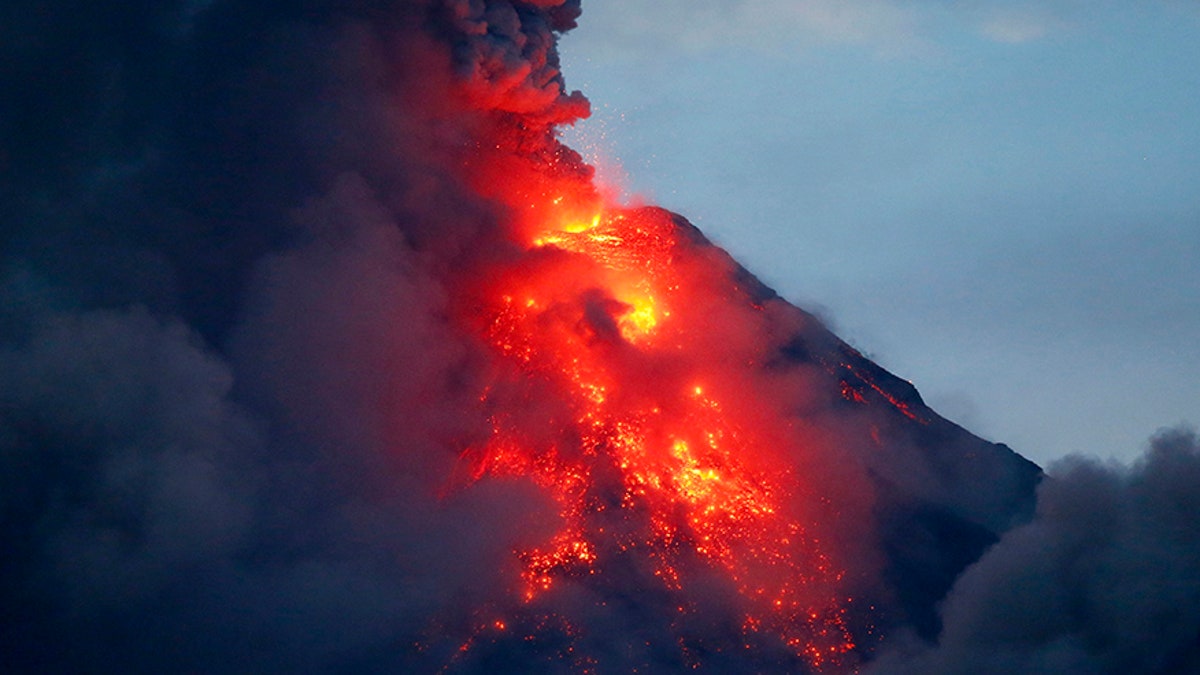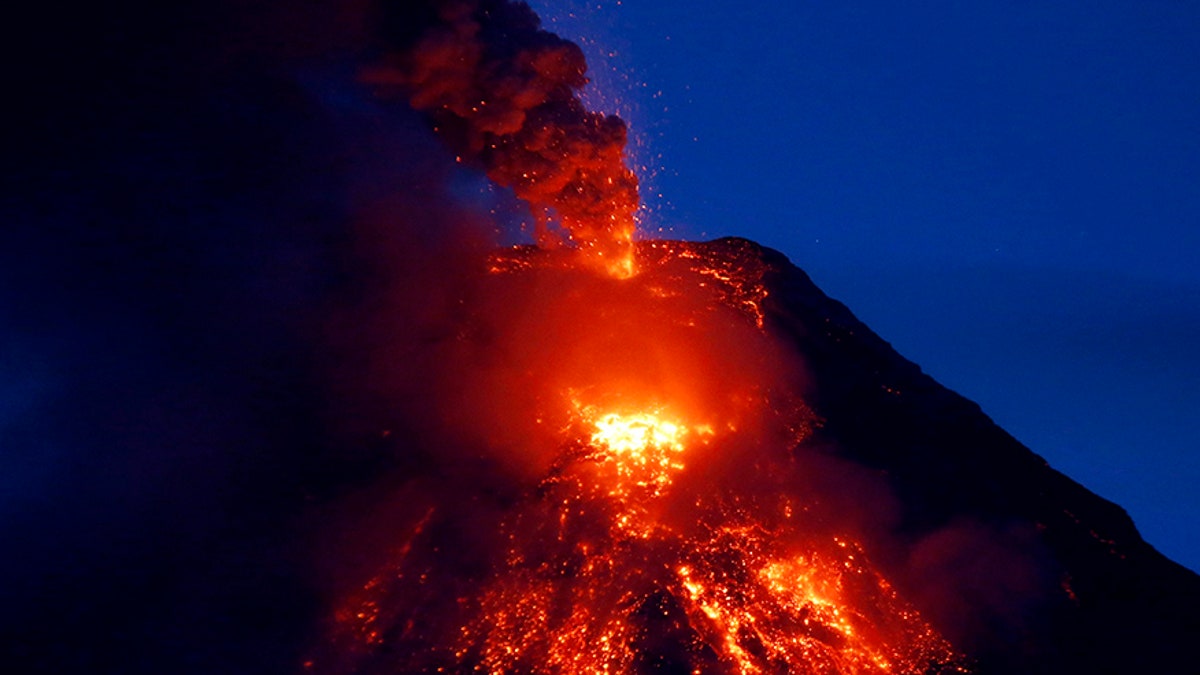Erupting volcano lights up night sky in Philippines
Mount Mayon shoots massive plumes of ash, lava into the sky forcing thousands of villagers to evacuate; officials set the danger zone at a 5-mile radius from the crater.
The Philippines' most active volcano erupted three more times on Tuesday, with one blast generating one of most massive lava displays since it started acting up more than a week ago, the Philippine Institute of Volcanology and Seismology says.
The eruptions occurred a day after officials raised Mount Mayon's alert level to four on a scale of five. Lava fountains gushed up 2,300 feet above Mayon's crater and ash plumes rose up to 1.9 miles Monday night.
"We couldn't sleep last night because of the loud rumblings. It sounded like an airplane that's about to land," Quintin Velardo, a 59-year-old farmer, told The Associated Press at an evacuation center in nearby Legazpi city where he took his wife, children and grandchildren on Tuesday.
More than 56,000 villagers have fled to evacuation centers so far as the eruptions become increasingly dangerous. The volcano last erupted in 2014, according to Reuters.

Jan. 23, 2018: The Mayon volcano spews red-hot lava in another eruption as seen from Legazpi city, Albay province, roughly 200 miles southeast of Manila, Philippines. (AP)
Velardo said he need to return to his village though, about 5 miles from the volcano, to take his cow and water buffalo to safety. A few minutes later, the volcano belched a massive column of grayish ash that punched through white clouds into the blue sky.
"There it goes again," Velardo said as his family huddled near him.
Authorities warned a violent eruption may occur in hours or days, characterized by more rumblings and pyroclastic flows — superheated gas and volcanic debris that race down the slopes at high speeds, vaporizing everything in their path.
Officials in Albay province, where Mount Mayon and Legazpi are, shuttered the regional airport Tuesday because of ashfall, impacting 25 flights, Reuters reported. Three towns in the area also closed public and private offices to keep workers away.
After Monday's explosion, officials raised Mayon's alert level, and the danger zone was expanded to 5 miles from the crater, requiring thousands more residents to be evacuated, including at least 12,000 who returned to their homes last week as Mayon's rumblings temporarily eased. This week, they scrambled back to the emergency shelters.

Jan. 23, 2018: Mayon has spewed fountains of red-hot lava and massive ash plumes anew in a dazzling but increasingly dangerous eruption that has sent 56,000 villagers fleeing to evacuation centers. (AP)
At least 56,217 people were taking shelter in 46 evacuation camps Tuesday and army troops and police were helping move more villagers from their homes, officials said.
Authorities struggled to prevent villagers from sneaking back to check on their homes and farms and to watch a popular cockfight in Albay's Santo Domingo town despite the risks and police patrols and checkpoints, said Cedric Daep, a provincial disaster response official.
In a sign of desperation, Daep told a news conference that he has recommended electricity and water supplies be cut in communities within the no-go zones to discourage residents from returning.
"If pyroclastic flows hit people, there is no chance for life," Daep said. "Let us not violate the natural law, avoid the prohibited zone, because if you violate, the punishment is the death penalty."
The daytime eruptions have plunged nearby villages into darkness and sent lava, rocks and debris cascading down Mayon's slopes toward the no-entry danger zone. There have been no reports of deaths or injuries.
Volcanic ash fell Monday in more than a dozen towns in coconut-growing Albay and nearby Camarines Sur province, with visibility heavily obscured in a few towns because of the thick gray ash, Jukes Nunez, another Albay provincial disaster response officer, said by telephone.

The volcano last erupted in 2014, according to Reuters. (AP)
"It was like nighttime at noon, there was zero visibility in some areas because the ash fall was so thick," Nunez said.
More than 30,000 ash masks and about 5,000 sacks of rice, along with medicine, water and other supplies, were being sent to evacuation centers, Office of Civil Defense regional director Claudio Yucot said late Monday.
Food packs, water, medicine and other relief goods remain adequate but may run out by mid-February if the eruption continues and new supplies fail to come on time, officials said.
With its near-perfect cone, Mayon has long been popular with climbers and tourists but has erupted about 50 times in the last 500 years, sometimes violently. The 8,070-foot volcano has generated tourism revenues and jobs in Albay, about 210 miles southeast of Manila.
In 2013, an ash eruption killed five climbers who had ventured near the summit despite warnings. Its most destructive eruption, in 1814, killed more than 1,200 people and buried the town of Cagsawa in volcanic mud. The belfry of Cagsawa's stone church still juts from the ground in an eerie reminder of Mayon's fury.
Since childhood, Velardo, the farmer, said he has gambled his and his family's lives in Mayon's shadow but that he and thousands of other landless farmers have no place else to go. "I tell my grandchildren to study hard so they can live elsewhere without a volcano to keep an eye on all your life."
The Associated Press contributed to this report.
